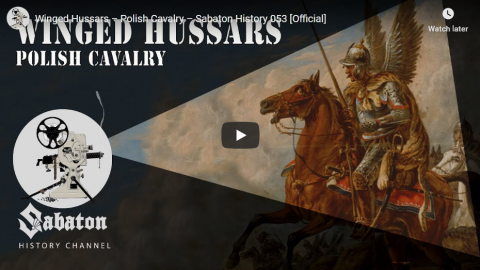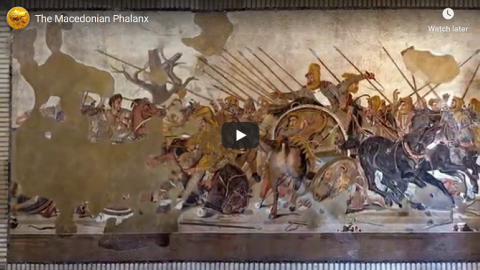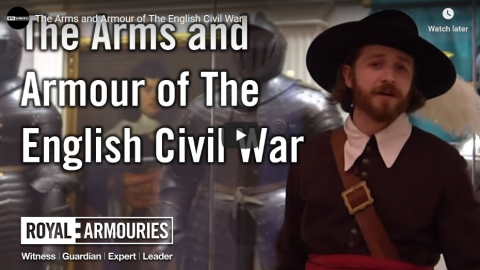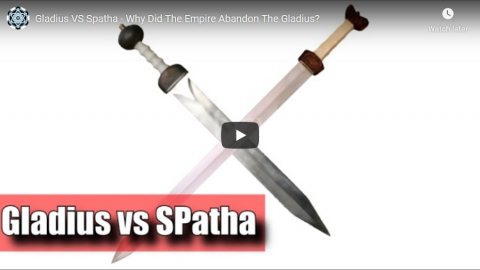Sabaton History
Published 6 Feb 2020The Winged Hussars have arrived!
By the 17th century it seemed like the golden age of the Winged Hussars had come to an end. Heavily armored, clad in steel and leopard skins, they had once charged over the battlefields with their wings proudly flying in the wind. But as the city of Vienna came under siege by the Ottoman Empire, the Polish Winged Hussars once more set out to meet their foes on the battlefield. Prepare for a thunderous charge that would go down in history.
Support Sabaton History on Patreon: https://www.patreon.com/sabatonhistory
Listen to “Winged Hussars” on the Last Stand Album:
CD: http://bit.ly/TheLastStandStore
Spotify: http://bit.ly/TheLastStandSpotify
Apple Music: http://bit.ly/TheLastStandItunes
iTunes: http://bit.ly/TheLastStandItunes
Amazon: http://bit.ly/TheLastStandAmz
Google Play: http://bit.ly/TheLastStandGooglePlayWatch the official lyric video of “Winged Hussars” here:
https://www.youtube.com/watch?v=rcYhY…Check out the trailer for Sabaton’s new album The Great War right here: https://www.youtube.com/watch?v=HCZP1…
Listen to Sabaton on Spotify: http://smarturl.it/SabatonSpotify
Official Sabaton Merchandise Shop: http://bit.ly/SabatonOfficialShopHosted by: Indy Neidell
Written by: Markus Linke and Indy Neidell
Directed by: Astrid Deinhard and Wieke Kapteijns
Produced by: Pär Sundström, Astrid Deinhard and Spartacus Olsson
Creative Producer: Joram Appel
Executive Producers: Pär Sundström, Joakim Broden, Tomas Sunmo, Indy Neidell, Astrid Deinhard, and Spartacus Olsson
Post-Production Director: Wieke Kapteijns
Edited by: Iryna Dulka
Sound Editing by: Marek Kaminski
Maps by: Eastory – https://www.youtube.com/c/eastoryArchive by: Reuters/Screenocean https://www.screenocean.com
Music by Sabaton.An OnLion Entertainment GmbH and Raging Beaver Publishing AB co-Production.
© Raging Beaver Publishing AB, 2019 – all rights reserved.
February 7, 2020
“Winged Hussars” – Polish Cavalry – Sabaton History 053 [Official]
February 4, 2020
The Macedonian Phalanx
HistoryMatters
Published 30 Jan 2016A short introduction to the Macedonian phalanx, from conception to demise.
January 24, 2020
The Arms and Armour of The English Civil War
Royal Armouries
Published 21 Dec 2017The Royal Armouries’ English Civil War collection boasts an array of infantry and cavalry arms and armour from the 1640s. Delve into this turbulent historical period with a look at some cavalry arms and armour.
Where to find us:
⚔Website: https://royalarmouries.org/home
⚔Blog: https://blog.royalarmouries.org/
⚔Twitter: https://twitter.com/Royal_ArmouriesThe Royal Armouries is the United Kingdom’s national collection of arms and armour. On this channel, discover what goes on behind the scenes at the museum and to see our collection come to life. From combat demonstrations to jousting coverage to behind the scenes tours with our curators, we’ve got it covered.
Have a question about arms and armour? Feel free to leave us a comment and we’ll do our best to answer it.
January 6, 2020
Macedonian Battle Tactics
Historia Civilis
Published 5 Jul 2017Patreon | http://patreon.com/HistoriaCivilis
Donate | http://www.paypal.com/cgi-bin/webscr?…
Merch | http://teespring.com/stores/historiac…
Twitter | http://twitter.com/HistoriaCivilis
Website | http://historiacivilis.comSources:
Parallel Lives, by Plutarch: http://amzn.to/2sOfr4O
Alexander of Macedon, by Peter Green: http://amzn.to/2rMJqpn
Alexander the Great, by Robin Lane Fox: http://amzn.to/2sOKqh3
Ghost on the Throne, by James Romm: http://amzn.to/2tpuNxqWe are a participant in the Amazon Services LLC Associates Program, an affiliate advertising program designed to provide a means for us to earn fees by linking to Amazon.com and affiliated sites.
Music:
“Seeing the Future,” by Dexter Britain
“Infados,” by Kevin MacLeod
“Drums of the Deep,” by Kevin MacLeod
“Hallon,” by Christian Bjoerklund
December 30, 2019
How A Man Shall Be Armed: 13th Century
Royal Armouries
Published 20 Feb 2017Discover how knights of the 13th Century would prepare themselves for battle, as armourers sought more creative and practical solutions to counter the threat of new weaponry.
November 29, 2019
Why was Cavalry Used in Warfare? | Animated History
The Armchair Historian
Published 11 Jan 2018Why was Cavalry used in warfare?
Our Website: https://www.thearmchairhistorian.com/
Our Twitter:
@ArmchairHistSources: https://en.wikipedia.org/wiki/Horses_…
http://www.napolun.com/mirror/napoleo…
http://napoleonistyka.atspace.com/cav…
https://en.wikipedia.org/wiki/Cavalry…
https://ehistory.osu.edu/exhibitions/…
http://www.cincinnaticwrt.org/data/cc…
http://www.napolun.com/mirror/web2.ai…Music: Music: Antonio Salieri: “Twenty six variations on La Folia de Spagna“
From the comments:
The Armchair Historian
1 year agoSo two things….
1. A lot of people are saying the video is an oversimplification. You’re exactly right, this is a prelude of a series I’ll be doing covering all types of cavalry from all different eras, as well as tanks. I’ll be covering mainly the abstract, and the concepts, and less of all the specific numbers and statistics. This video is to act as an intro.
2. A lot of people are saying cavalry and tanks aren’t the same. You’re right again, but here’s what I meant in the video. The tank replaced the cavalry, and still fulfills the abstract usage of cavalry, as a decisive shock unit. You don’t have many of them, they’re more expensive, and they hit harder than their counterparts, infantry, and artillery. Of course tanks are not used in the same way cavalry was in warfare, but as cavalry left they were replaced by armor. In fact, many people tried to use tanks just like cavalry, but it didn’t work. It took up until the end of WW2 for most generals to realize this.
Hope that clears some stuff up,
Griff
To give an example of his second point, the British use of “cruiser” tanks in the Western Desert campaign of World War 2 typified the “it’s just an armoured horse” view of tanks. Disproportional British tank losses to German anti-tank guns was the usual result.
October 14, 2019
Cavalry Combat & Tactics during the Napoleonic Era
Military History Visualized
Published 20 Jan 2018This video gives insights in cavalry combat and tactics during the era of Napoleon. This includes cavalry types, forms of combat, formations, organization, principles and many more.
Link to History Gaming Verified: https://www.youtube.com/channel/UCoeY…
»» SUPPORT MHV ««
» patreon – https://www.patreon.com/mhv
» paypal donation – https://www.paypal.com/cgi-bin/webscr…Military History Visualized provides a series of short narrative and visual presentations like documentaries based on academic literature or sometimes primary sources. Videos are intended as introduction to military history, but also contain a lot of details for history buffs. Since the aim is to keep the episodes short and comprehensive some details are often cut.
» SOURCES «
Rothenberg Gunther E.: The Art of Warfare in the Age of NapoleonNosworthy, Brent: Battle Tactics of Napoleon and his Enemies
Bruce, Robert B.; Dickie, Iain; Kiley, Kevin; Pavkovic, Michael F.; Schneid, Frederick C.: Fighting Techniques of the Napoleonic Age 1792 – 1815: Equipment, Combat Skills, and Tactics
Ortenburg, Georg: Waffen der Revolutionskriege 1792-1848
Planert, Ute: “Die Kriege der Französischen Revoluation und Napoleons. Beginn einer neuen Ära der europäischen Kriegsgeschichte oder Weiterwirken der Vergangenheit?” In: Beyrau, Dietrich; Hochgeschwender, Michael; Langewiesche, Dieter (Hrsg.): Formen des Krieges. Von der Antike bis zur Gegenwart, S. 149-162
Rogers, H.C.B.: Napoleon und seine Armee / Napoleon’s Army
Browing, Peter: The Changing Nature of Warfare. The Development of Land Warfare from 1792 to 1945
Citino, Robert M.: The German Way of War
Chandler, David: The Art of Warfare in the Age of Marlborough
Philip J. Haythornthwaite: Weapons & Equipment Of The Napoleonic Wars
Hughes, B. P.: Firepower – Weapon Effectiveness on the Battlefield, 1630-1850
Lind, William S.: “Maneuver”; in: Margiotta, Franklin (ed): Brassey’s Encyclopedia of Land Forces and Warfare, p. 661-667
AskHistorians: How does a commander screen his army?
https://www.reddit.com/r/AskHistorian…Russell, Jill R.: With rifle and bibliography: General Mattis on professional reading
http://www.strifeblog.org/2013/05/07/…» DISCLAIMER «
Amazon Associates Program: “Bernhard Kast is a participant in the Amazon Services LLC Associates Program, an affiliate advertising program designed to provide a means for sites to earn advertising fees by advertising and linking to amazon.com.”Bernhard Kast ist Teilnehmer des Partnerprogramms von Amazon Europe S.à.r.l. und Partner des Werbeprogramms, das zur Bereitstellung eines Mediums für Websites konzipiert wurde, mittels dessen durch die Platzierung von Werbeanzeigen und Links zu amazon.de Werbekostenerstattung verdient werden können.
» TOOL CHAIN «
PowerPoint 2016, Word, Excel, Tile Mill, QGIS, Processing 3, Adobe Illustrator, Adobe Premiere, Adobe Audition, Adobe Photoshop, Adobe After Effects, Adobe Animate.
September 22, 2019
Gladius VS Spatha – Why Did The Empire Abandon The Gladius?
Metatron
Published on 11 Feb 2017If the famous Gladius/rectangular Scutum combo had proven to be so effective for so many centuries why did the Late Empire Romans choose to abandon it in favour of a spatha/round shield combination? Here is what I think.
Gladius was one Latin word for sword, and is used to represent the primary sword of Ancient Roman foot soldiers.
A fully equipped Roman legionary after the reforms of Gaius Marius was armed with a shield (scutum), one or two javelins (pila), a sword (gladius), often a dagger (pugio), and, perhaps in the later Empire period, darts (plumbatae). Conventionally, soldiers threw javelins to disable the enemy’s shields and disrupt enemy formations before engaging in close combat, for which they drew the gladius. A soldier generally led with the shield and thrust with the sword. All gladius types appear to have been suitable for cutting and chopping as well as thrusting.
Gladius is a Latin masculine second declension noun. Its (nominative and vocative) plural is gladiī. However, gladius in Latin refers to any sword, not specifically the modern definition of a gladius. The word appears in literature as early as the plays of Plautus (Casina, Rudens).
Modern English words derived from gladius include gladiator (“swordsman”) and gladiolus (“little sword”, from the diminutive form of gladius), a flowering plant with sword-shaped leaves.
Gladii were two-edged for cutting and had a tapered point for stabbing during thrusting. A solid grip was provided by a knobbed hilt added on, possibly with ridges for the fingers. Blade strength was achieved by welding together strips, in which case the sword had a channel down the center, or by fashioning a single piece of high-carbon steel, rhomboidal in cross-section. The owner’s name was often engraved or punched on the blade.
August 19, 2019
The Peterloo Massacre
In Spiked on Friday, Brendan O’Neill marked the 200th anniversary of a brutal suppression of thousands of protestors demanding the right to vote in Britain:
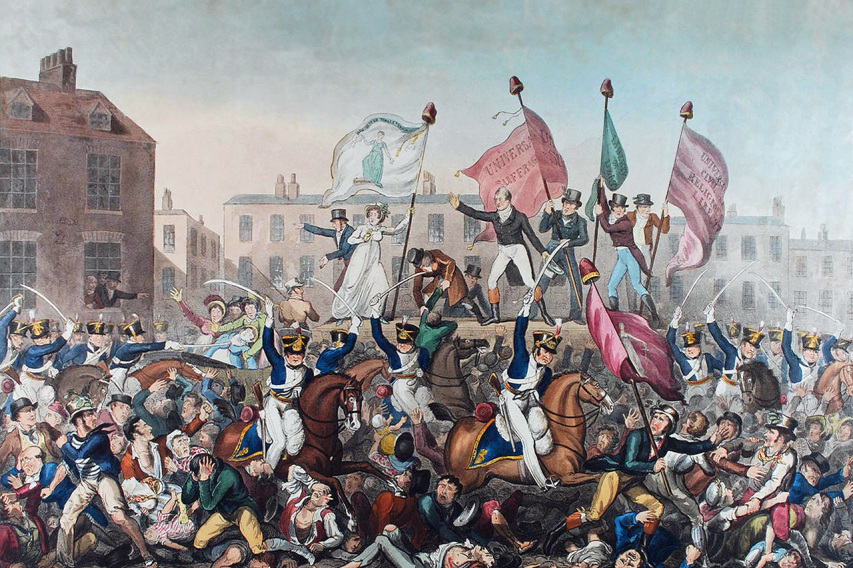
The Peterloo Massacre by Richard Carlile (1790-1843)
To Henry Hunt, Esq., as chairman of the meeting assembled in St. Peter’s Field, Manchester, sixteenth day of August, 1819, and to the female Reformers of Manchester and the adjacent towns who were exposed to and suffered from the wanton and fiendish attack made on them by that brutal armed force, the Manchester and Cheshire Yeomanry Cavalry, this plate is dedicated by their fellow labourer, Richard Carlile: a coloured engraving that depicts the Peterloo Massacre (military suppression of a demonstration in Manchester, England by cavalry charge on August 16, 1819 with loss of life) in Manchester, England.
All the poles from which banners are flying have Phrygian caps or liberty caps on top. Not all the details strictly accord with contemporary descriptions; the banner the woman is holding should read: Female Reformers of Roynton — “Let us die like men and not be sold like slaves”.
Manchester Library Services via Wikimedia Commons.
Today is the 200th anniversary of the Peterloo Massacre, when working people in Manchester were attacked and murdered by cavalry forces for daring to demand the right to vote. And what is our political class doing on this anniversary of such an important event in British political history? They are plotting, tirelessly, to overthrow something that millions of working-class people, and others, voted for: Brexit. They are doing what the Peterloo butchers did, only by political means and court cases rather than with bayonets and sabres. Our current political rulers may not physically attack the masses for having the temerity to use their democratic voices — not yet, anyway — but they view us with the exact same seething, elitist contempt as those who did attack the masses in St Peter’s Field on 16 August 1819.
Around 60,000 men, women and children gathered in St Peter’s Field in Manchester 200 years ago to demand parliamentary representation. They wanted that most basic and essential democratic right: the right to vote. The teeming industrial city of Manchester had no elected MPs in parliament. The old “rotten boroughs” system meant that often sparsely populated rural areas sent MPs to the Commons, involving much patronage and sometimes even the buying of votes by wealthy aspiring politicians, while newly industrialised cities full of the growing urban working classes had little to no political representation. Against a background of post-Napoleonic Wars economic depression and a fast-spreading radical desire for meaningful democratic change, the tens of thousands of marchers arrived in St Peter’s Field with a clear demand: let us vote, let us speak.
What happened next is well known. They were attacked by cavalry forces. Troops on horseback wielded sabres against the democratic crowd. They slashed and stabbed, killing 18 people. Around 500 were injured. The slaughter was given the name “Peterloo” as an ironic comparison to the Battle of Waterloo that took place four years earlier, in 1815. The bourgeoisie’s assault on the working-class democrats of Manchester had a deep impact on the radical psyche. New movements emerged in subsequent years, including the Chartists, the working-class movement for democratic representation. But it would be decades before the right to vote had been established across society. In 1867 some working-class men got the right to vote. In 1918, all men and some women got the right to vote. In 1928, finally all women got the vote. The General Election of 1929, 110 years after the march to St Peter’s Field, was the first election in which all adults had the right to vote.
The 200th anniversary of this bloody assault on working-class democrats ought to be a major occasion. It should be a reminder of the incredible, heroic sacrifices earlier generations made to secure people’s right to express themselves, to vote, and to see their votes be enacted. And yet while some in the political and media class will today pay lip service to the heroes of St Peter’s Field and express regret about the massacre of 18 of them, most of the elites will be too busy to do anything of the kind. Busy doing what? Trying to override and crush the votes of 17.4million people, which includes millions of working-class people and eight million women. It is a genuinely alarming and revealing moment: the 200th anniversary of the Peterloo Massacre arrives and the political set is engaged in an effective coup against the people; in a war against “No Deal Brexit” (which really just means a war against Brexit); in a concerted effort to force the ignorant public, as they see us, to vote for a second time and to give the “right” answer on this occasion.
May 21, 2019
Armoured Vehicles of the Invasion of France 1940, by The Chieftain – WW2 Special
World War Two
Published on 20 May 2019The Chieftain takes you on an extensive walkthrough of the armoured vehicles used by both sides during the German invasion of France in 1940.
The Chieftain’s channel: https://www.youtube.com/user/TheChief…
April 22, 2019
Siege of Vienna – Charge of the Winged Hussars – Extra History – #3
Extra Credits
Published on 20 Apr 2019Leopold knew it was time to get the Holy Roman Empire involved if he wanted to keep Vienna, but it wouldn’t be as simple as asking for a favor. Charles of Lorraine and Sobieski of Poland would be the ones to lead the charge on the battlefield against the Janissaries.
Join us on Patreon! http://bit.ly/EHPatreon
October 20, 2018
Cavalry was a stupid idea
Lindybeige
Published on 28 Aug 2016The Great Courses Plus free trial: http://ow.ly/fA12302OFSt
Riding a horse into battle is not a technique easy to adopt. The first man to suggest it may have been laughed at.
Support me on Patreon: https://www.patreon.com/Lindybeige
A long ramble by me. Possibly I should have done one video about Celtic/Roman four-pommelled saddles, and a separate one about how cavalry took a long time to develop.
I wasn’t quite at my peak while making this one. I came back from abroad with a virus, and had spent the previous day coughing.
Lindybeige: a channel of archaeology, ancient and medieval warfare, rants, swing dance, travelogues, evolution, and whatever else occurs to me to make.
▼ Follow me…
Twitter: https://twitter.com/Lindybeige I may have some drivel to contribute to the Twittersphere, plus you get notice of uploads.
website: www.LloydianAspects.co.uk
July 5, 2018
Tales of Cromwell tanks
Lindybeige
Published on 6 Apr 2016War memoirs are filled with amazing anecdotes. Here I relate two, and ramble a bit about British WW2 tank units.
Support me on Patreon: https://www.patreon.com/LindybeigeI am likely to return to this topic – anecdotes from war memoirs. It is a rich vein of stories. These come from Troop Leader by Bill Bellamy, which describes the author’s time commanding a trio of fast Cromwell tanks in World War Two, when fighting the Germans in Holland.
Lindybeige: a channel of archaeology, ancient and medieval warfare, rants, swing dance, travelogues, evolution, and whatever else occurs to me to make.
May 24, 2018
Medieval tank – The 13th Century Knight I IT’S HISTORY
IT’S HISTORY
Published on 23 May 2018This time we will take you back to middle ages. It’s 13th century – what did medieval armor look like?
May 8, 2018
Charge of the Light Brigade | Animated History
The Armchair Historian
Published on 28 Dec 2017The Charge of the Light Brigade, Animated History

